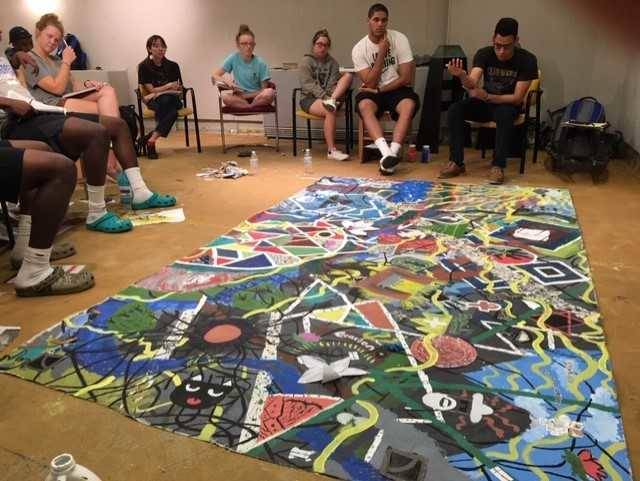LAURINBURG — As meticulously noted in “The Mythic School of the Mountain: Black Mountain College” (Our State magazine, Joseph Bathanti, NC poet laureate, a small and rural college became known as perhaps the boldest and most progressive educational experience in American history.
The purpose of the college is “to lead on to creative consciousness a carefully selected group of young men and women who are eager to know, to will and to do.”
And it was revolutionary: no directors or trustees; not accredited; hand-made diplomas (for those who actually graduated, perhaps 60); pedagogical direction was whatever students and teachers agreed upon; no grades.
Begun by Professor John Andrew Rice who had been dismissed from Rollins College (Winter Park, Florida), Black Mountain College would begin and find its home in 1933 north of Asheville, a few miles from Black Mountain and sharing space with the Blueridge Assembly Christian conference and training center and then moving to nearby Lake Eden in 1941. It would last until 1956 with a dozen or so faculty; about 1,200 students attended over the years. The school would serve as a metaphor for arts, literature, music, poetry, even self-sufficiency (a farm to grow their food). Notables on their campus included Albert Einstein, John Dewey, Aldous Huxley, Buckminster Fuller and Thornton Wilder.
Bathanti adds: “There is nothing to commemorate its considerable glory other than a terse epitaph etched into a silver historical marker on U.S. Highway 70 at West College Street, traveling west out of the charming little town of Black Mountain: ‘Black Mountain college: Est. in 1933. Closed 1956. Experimental schools with emphasis on fine arts and progressive education. Campus was 3 mi. NW.’”
One building remains from the former campus, now part of a summer camp.
A collection of Black Mountain materials and photos can be found in the local Black Mountain museum.
Just a few miles north of Black Mountain is the well-known Montreat Conference Center for the Presbyterian Church USA.
That would have been the conclusion to the story except for the intervention of St. Andrews professor and poet Ron Bayes in 1974 (now emeritus and living at Scotia Village) along with English professor Whitney Jones who created what was the first Black Mountain College Festival at St. Andrews (Presbyterian College), featuring Buckminster Fuller and a geodesic dome built on the grass field next to the Morgan Liberal Arts Building.
Bathanti, who taught at St. Andrews and considers Ron Bayes his “Literary Godfather,” writes that Bayes had known some of the Black Mountain writers and had kept in touch with them, a few who had been visitors to St. Andrews even before the 1974 celebration — 1989 would bring another reprise of Black Mountain along with SA alum and poet/author Tom Patterson and the Jimmy Morgan Jazz Band.
St. Andrews alumni and friends organized a trip to Black Mountain in 2005 and spent three days touring various areas connected to the college.
And in 2016, Ted Wojtasik, assistant professor of English and Creative Writing, planned the fall semester as a tribute with arts, music, poetry, prose readings and dance. His line-up included Bathanti, Patterson, Basil and Martha King, Penelope Creeley, Helen Simoneau Danse Company and Douglas Dunn Dance Company. Wojtasik read his poetry and Neal Bushoven, who was teaching at St. Andrews in 1974, reminisced about the earlier festival.
Out of Black Mountain and the St. Andrews association, the Department of Liberal and Creative Arts established the Black Mountain Scholars, a group of students who engage in experimental learning and performance, using the traditions and history of BMC as inspiration. The department has also started teaching cross-over classes that emphasize a connection between disciplines: art with history, creative writing with music, politics with theatre, etc.
Currently during the 2019 spring semester, the St. Andrews Black Mountain Scholars program joined the history and religious studies faculty in a team-taught exploration of the relationship between religious iconography and the Black Mountain College approach to learning. David Herr and Tanner Capps offered Lived Theology and the Black Mountain Ethos. Students explored the relationship between religion as a belief system and religion as a set of practices by exploring a wide range of world religions and their expressions. They also learned the history of Black Mountain College and the long association many of its students and faculty had with St. Andrews.
Professors Herr and Capps presented the course following the tenants of Black Mountain College that included an informal class environment, student directed inquiry, and student-faculty collaboration. The students shared their individual research efforts in an artistic collaboration (as pictured) that served as the final project. Using a 15-by-8-foot canvas, they created a mural blending interpretations of religious iconography with reflections on the ideas they gathered from learning about Black Mountain College. The mural will eventually be displayed in the Division of Liberal and Creative Arts’ home, the Vardell Building, which is undergoing renovation following Hurricane Florence.
Black Mountain Scholars have returned to Black Mountain where they spent time with Bathanti, stayed on the original campus and conducted research into Black Mountain College through the NC Western Regional Archives, the BMC Museum, and the Asheville Museum of Art. Another trip to Black Mountain is planned for May 2020.
Significant sources of information about Black Mountain College are available in the DeTamble Library archives and Library Director Mary McDonald.
Additional information about students interested in becoming Black Mountain Scholars and scholarships can be accessed through Liberal Arts Division Chairman David Herr at [email protected].
James R. Henery is the director of communications and university chaplain for St. Andrews University.

